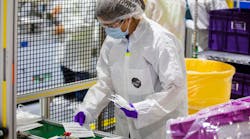In an effort to offer the manufacturing sectors some best practices on how companies can keep employees safe while keeping plants open, The Manufacturing Leadership Council, a division of the National Association of Manufacturers, released a new report, New Operational Practices to Consider in the Time of COVID-19, on May 20th.
“Manufacturers have been on the front lines throughout this crisis, and this guide leverages the experiences and real-world practices that manufacturers across America have put into place,” said NAM CEO Jay Timmons. "We’re all looking to get back to some sense of normalcy, but that’s not possible unless we can protect manufacturing workers. By collecting these practices, the MLC is helping all manufacturers continue to set high standards for protecting employees, families and communities while creating products essential to our daily lives.”
These practices meet or exceed existing guidelines from the various federal agencies while also mitigating operational and business risks that are outside the scope of such guidance.
“Since this crisis began, the NAM has been working with Vice President Pence and the Coronavirus Task Force, Centers for Disease Control and Prevention, Occupational Safety and Health Administration and others to relay real-time information from our industry and to ensure manufacturers received the critical guidance they needed to operate safely,” said NAM COO Todd Boppell.
“The MLC has also convened thousands of manufacturing leaders to share practices and develop new ideas for operating safely through this crisis. Manufacturers have come together to help each other and to help our country.”
This information is not meant as authoritative legal, medical, or regulatory guidance or advice. It is not an exhaustive list of operational practices in the COVID-19 environment but rather represents some of the most common “best practices” communicated to the National Association of Manufacturers.
The following are a couple of sections from the report.
Facilities and Traffic Management
--Companies are limiting and discouraging congregation of staff in any area where they must be closer together than six feet and/or with poor ventilation characteristics.
--Cafeterias and break rooms are frequently either closed, or they are rearranged in reduced seating formations to prevent people from sharing tables. In some cases, staff are asked to take breaks or eat lunches in their cars to maintain separation while getting off their feet. Companies are using ample signage to communicate room occupancy limits.
-- Companies are seeking to install touchless appliances wherever possible—including all sinks and paper towel holders.
-- Major emphasis is placed on frequent hand washing or hand sanitizing, and, when possible, the appropriate sinks or supplies are located throughout the facility to accommodate the increased frequency.
--Companies are focused on cleaning restrooms more frequently, and some toilets or sinks may be blocked off to help maintain social distancing.
--Wherever possible, doors are propped open to eliminate a frequent touchpoint for many staff hands. Other companies are installing hardware that allows workers to open doors with their forearms or with a foot pedal.
-- Hallways and other walkways through buildings may be designated as one-way to reduce close-proximity passing of staff.
--Some companies are increasing the use of radios, text messages and email to reduce staff movement and face-to-face communication.
Shifts and Team Design
--Many companies realize that any worker may get infected or sick at any time, no matter where the exposure occurs. They, therefore, endeavor to ensure that each worker is only interacting with a very limited number of coworkers to minimize the number of people who might be exposed in the workplace and then quarantined or infected as a result.
--Increasing the time between shifts allows for policies that ensure all workers from one shift are off-premises before the next shift arrives, preventing incidental contact between workers on different shifts.
--Some facilities have divided workers within the same shift into specific smaller work teams. These teams may be designated with a specific marked floor area in the facility or designated by color of uniforms or other visual cues. Workers may need to interact at closer distances with those on their designated team, but they explicitly do not do so with members of any other team.
--Hand-offs are often a critical and normal part of factory operations; everything from clipboards to raw materials
The report also includes other sections:
- Site Access to Mitigate Exposure
- Workstation Measures to Promote Social Distancing
- Leave Policies
- Illness or Diagnosis Response
- Essential Travel Policies
- Returning Nonessential Workers




